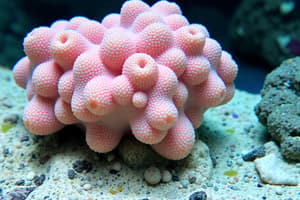Podcast
Questions and Answers
What is the meaning of the term 'Porifera' in the phylum name?
What is the meaning of the term 'Porifera' in the phylum name?
Porifera means pore-bearing, derived from Latin 'poros' meaning pore and 'ferre' meaning to bear.
What is the main function of the canal system in sponges?
What is the main function of the canal system in sponges?
The canal system helps in food gathering, circulation, respiration, and removal of waste.
What are the special flagellated cells lining the spongocoel and canals in sponges?
What are the special flagellated cells lining the spongocoel and canals in sponges?
Choanocytes or collar cells.
What is the mode of nutrition in sponges?
What is the mode of nutrition in sponges?
What is the characteristic feature of the body organization in Cnidarians?
What is the characteristic feature of the body organization in Cnidarians?
What is the function of cnidoblasts in Cnidarians?
What is the function of cnidoblasts in Cnidarians?
What is the level of organization in Cnidarians?
What is the level of organization in Cnidarians?
What is the function of the coelenteron in Cnidarians?
What is the function of the coelenteron in Cnidarians?
Flashcards are hidden until you start studying
Study Notes
Phylum Porifera (Sponges)
- Also known as pore-bearing animals, they are commonly called sponges
- They are aquatic, mostly marine, and a few species live in freshwaters
- They are primitive, multicellular, and sessile with a cellular level of organization
- Their cells are loosely arranged and they possess a water transport system (canal system)
- Water enters through minute pores called ostia, passes through a central cavity (spongocoel), and exits through the osculum
- This water transport system helps in food gathering, circulation, respiration, and waste removal
- Choanocytes or collar cells are special flagellated cells lining the spongocoel and canals
- Their body is supported by a skeleton made up of calcareous and siliceous spicules or spongin or both
- Nutrition is holozoic and intracellular
- All sponges are hermaphrodites, producing both ova and sperms
- They reproduce asexually by fragmentation or gemmule formation and sexually by gamete formation
- Development is indirect with different types of larval stages, such as parenchymula and amphiblastula
Phylum Cnidaria
- Also known as Cnidarians (previously called Coelenterata)
- They are aquatic, sessile or free-swimming, solitary or colonial forms with radial symmetry
- The name Cnidaria comes from cnidocytes or cnidoblasts with stinging cells or nematocysts on tentacles
- Cnidoblasts are used for anchorage, defense, and capturing prey
- They exhibit tissue-level organization and are diploblastic
- They have a central vascular cavity or coelenteron, which serves both digestive and circulatory functions
- The coelenteron has a single opening called the mouth or hypostome, which serves both ingestion and egestion
- Digestion is both extracellular and intracellular
- Their nervous system is primitive and consists of a diffused nerve net
- Cnidarians like corals have a skeleton made up of calcium carbonate
- They exhibit two basic body forms: polyp and medusa
- Polyp forms are sessile and cylindrical (e.g., Hydra, Adamsia), while medusa forms are umbrella-shaped and free-swimming
- Cnidarians that exist in both forms exhibit alternation of generations in their life cycle (Metagenesis)
- The polyp represents the asexual generation, and the medusa represents the sexual generation
- Polyps produce medusa asexually, and medusa forms polyps sexually
- Development is indirect and includes a free-swimming ciliated planula larva
Studying That Suits You
Use AI to generate personalized quizzes and flashcards to suit your learning preferences.




